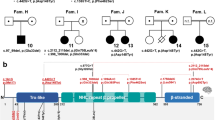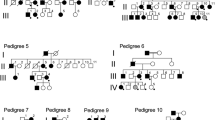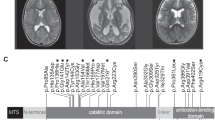Abstract
Lafora disease (LD) is a severe form of progressive myoclonus epilepsy inherited in an autosomal recessive fashion. It is associated with biallelic pathogenic variations in EPM2A or NHLRC1, which encode laforin and malin, respectively. The disease usually starts with adolescent onset seizures followed by progressive dementia, refractory status epilepticus and eventually death within 10 years of onset. LD is generally accepted as having a homogenous clinical course with no considerable differences between EPM2A or NHLRC1 associated forms. Nevertheless, late-onset and slow progressing forms of the disease have also been reported. Herein, we have performed clinical and genetic analyses of 14 LD patients from 12 different families and identified 8 distinct biallelic variations in these patients. Five of these variations were novel and/or associated with the LD phenotype for the first time. Interestingly, almost half of the cases were homozygous for the rare rs769301934 (NM_198586.3(NHLRC1): c.436 G > A; p.(Asp146Asn)) allele in NHLRC1. A less severe phenotype with an onset at a later age may be the reason for the biased inflation of this variant, which is already present in the human gene pool and can hence arise in the homozygous form in populations with increased parental consanguinity.
This is a preview of subscription content, access via your institution
Access options
Subscribe to this journal
Receive 12 print issues and online access
$259.00 per year
only $21.58 per issue
Buy this article
- Purchase on Springer Link
- Instant access to full article PDF
Prices may be subject to local taxes which are calculated during checkout



Similar content being viewed by others
References
Verhalen B, Arnold S, Minassian BA. Lafora Disease: a Review of Molecular Mechanisms and Pathology. Neuropediatrics. 2018;49:357–62.
Malek N, Stewart W, Greene J. The progressive myoclonic epilepsies. Pr Neurol. 2015;15:164–71.
Turnbull J, Tiberia E, Striano P, Genton P, Carpenter S, Ackerley CA, et al. Lafora disease. Epileptic Disord. 2016;18:38–62.
Lesca G, Boutry-Kryza N, De Toffol B, Milh M, Steschenko D, Lemesle-Martin M, et al. Novel mutations in EPM2A and NHLRC1 widen the spectrum of Lafora disease. Epilepsia. 2010;51:1691–8.
Li H, Durbin R. Fast and accurate short read alignment with Burrows-Wheeler transform. Bioinformatics. 2009;25:1754–60.
Van Der Auwera GA, Carneiro MO, Hartl C, Poplin R, Del Angel G, Levy-Moonshine A, et al. From FastQ data to high confidence variant calls: the Genome Analysis Toolkit best practices pipeline. Curr Protoc Bioinforma. 2013;43:11.10.1–33.
Mclaren W, Gil L, Hunt SE, Riat HS, Ritchie GR, Thormann A, et al. The Ensembl Variant Effect Predictor. Genome Biol. 2016;17:122.
Robinson JT, Thorvaldsdóttir H, Winckler W, Guttman M, Lander ES, Getz G, et al. Integrative genomics viewer. Nat Biotechnol. 2011;29:24–6.
Richards S, Aziz N, Bale S, Bick D, Das S, Gastier-Foster J, et al. ACMG Laboratory Quality Assurance Committee. Standards and guidelines for the interpretation of sequence variants: a joint consensus recommendation of the American College of Medical Genetics and Genomics and the Association for Molecular Pathology. Genet Med. 2015;17:405–24.
Kuchtová A, Gentry MS, Janeček Š. The unique evolution of the carbohydrate-binding module CBM20 in laforin. FEBS Lett. 2018;592:586–98.
Wang J, Stuckey JA, Wishart MJ, Dixon JE. A unique carbohydrate binding domain targets the lafora disease phosphatase to glycogen. J Biol Chem. 2002;277:2377–80.
Coban-Akdemir Z, White JJ, Song X, Jhangiani SN, Fatih JM, Gambin T, et al. Identifying genes whose mutant transcripts cause dominant disease traits by potential gain-of-function alleles. Am J Hum Genet. 2018;103:171–7.
García-Gimeno MA, Knecht E, Sanz P, Lafora. Disease: a Ubiquitination-Related Pathology. Cells. 2018;7:87.
Baykan B, Striano P, Gianotti S, Bebek N, Gennaro E, Gurses C, et al. Late-onset and slow-progressing Lafora disease in four siblings with EPM2B mutation. Epilepsia. 2005;46:1695–7.
Salar S, Yeni N, Gündüz A, Güler A, Gökçay A, Velioğlu S, et al. Four novel and two recurrent NHLRC1 (EPM2B) and EPM2A gene mutations leading to Lafora disease in six Turkish families. Epilepsy Res. 2012;98:273–6.
Lanoiselée HM, Genton P, Lesca G, Brault F, De Toffol B. Are c.436G > A mutations less severe forms of Lafora disease? A case report. Epilepsy Behav Case Rep. 2014;2:19–21.
Franceschetti S, Gambardella A, Canafoglia L, Striano P, Lohi H, Gennaro E, et al. Clinical and genetic findings in 26 Italian patients with Lafora disease. Epilepsia. 2006;47:640–3.
Vilchez D, Ros S, Cifuentes D, Pujadas L, Vallès J, García-Fojeda B, et al. Mechanism suppressing glycogen synthesis in neurons and its demise in progressive myoclonus epilepsy. Nat Neurosci. 2007;10:1407–13.
Singh S, Ganesh S. Lafora progressive myoclonus epilepsy: a meta-analysis of reported mutations in the first decade following the discovery of the EPM2A and NHLRC1 genes. Hum Mutat. 2009;30:715–23.
Singh S, Ganesh S. Phenotype variations in Lafora progressive myoclonus epilepsy: possible involvement of genetic modifiers? J Hum Genet. 2012;57:283–5.
Grzybowska EA. Human intronless genes: functional groups, associated diseases, evolution, and mRNA processing in absence of splicing. Biochem Biophys Res Commun. 2012;20:1–6.
Nitschke F, Ahonen SJ, Nitschke S, Mitra S, Minassian BA. Lafora disease - from pathogenesis to treatment strategies. Nat Rev Neurol. 2018;14:606–17.
Acknowledgements
The authors are grateful to the patients and their relatives for their participation in this study. This work was supported by the grants of Scientific Research Projects Coordination Unit of Istanbul University (grant reference numbers TDP-2017-25510 and 25323). EY & YK and OO & BS have been fellows of The Scientific and Technology Research Council of Turkey (TUBITAK) projects with number: 113S331 and 214S222, respectively. We also thank to Turkish Academy of Sciences for the 2019 Distinguished Young Scientist Award to SAUI.
Author information
Authors and Affiliations
Corresponding author
Ethics declarations
Competing interests
The authors declare no competing interests.
Additional information
Publisher’s note Springer Nature remains neutral with regard to jurisdictional claims in published maps and institutional affiliations.
Supplementary information
Rights and permissions
About this article
Cite this article
Haryanyan, G., Ozdemir, O., Tutkavul, K. et al. The rare rs769301934 variant in NHLRC1 is a common cause of Lafora disease in Turkey. J Hum Genet 66, 1145–1151 (2021). https://doi.org/10.1038/s10038-021-00944-8
Received:
Revised:
Accepted:
Published:
Issue Date:
DOI: https://doi.org/10.1038/s10038-021-00944-8



